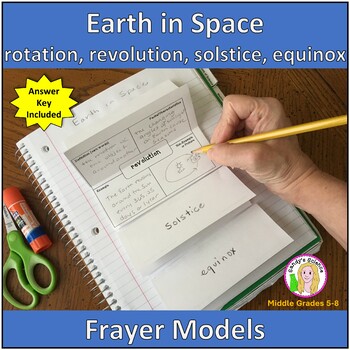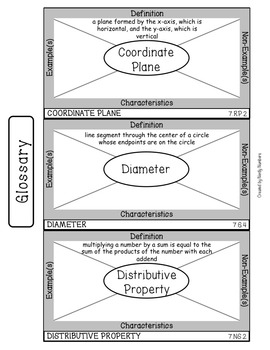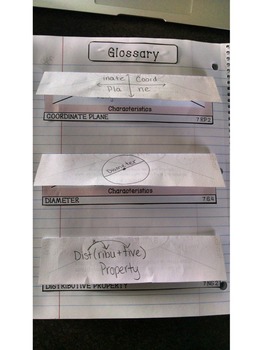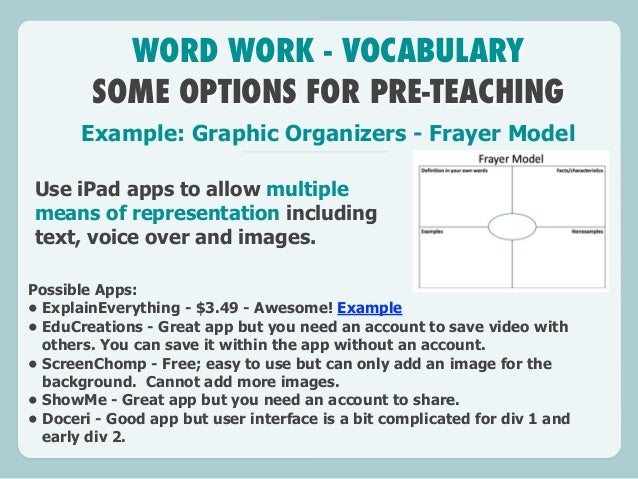video source: https://youtu.be/l2AjuMKVboQ
I might have understood harder math concepts better if we had done something like this with our math vocabulary words:

image source: https://www.pinterest.com/pin/296322850464240644/

image source: https://mathequalslove.blogspot.com/2014/02/linear-vs-non-linear-functions-inb-pages.html
I would use the Frayer Model as a tool to check for understanding as well. As they fill out the graphic organizer, you can observe by their answers, if they understand the concept.
The students can also use their graphic organizers as references throughout the unit. I would have students keep their graphic organizers in a binder. Each subject will have a binder. Here is an example of a science vocabulary binder.

image source: https://ecdn.teacherspayteachers.com/thumbitem/Rotation-Revolution-Vocabulary-Frayer-Model-1133725-1520150973/original-1133725-1.jpg
You could also use a writing journal.

image source: https://ecdn.teacherspayteachers.com/thumbitem/7th-Grade-CCSS-Math-Vocabulary-Frayer-Model-Interactive-Notebook-Glossary-1944735-1459779921/original-1944735-1.jpg
The contents could look like this:



images source:
https://ecdn.teacherspayteachers.com/thumbitem/7th-Grade-CCSS-Math-Vocabulary-Frayer-Model-Interactive-Notebook-Glossary-1944735-1459779921/original-1944735-1.jpgFor reading, it could look like this:
image source: http://thereadingnotebook.weebly.com/vocabulary.html
You can even use the Frayer Model with storyboardthat.com! What do I love about this? If you know me, you probably guessed it. Pictures!!! I love that it combines words with pictures. I think the visuals will help students remember the definitions better and really understand the concepts. I think student will love creating cartoon Frayer model vocabulary words. They can print them out or their notebook can be an e-notebook and save a tree!

image source: https://www.pinterest.co.uk/pin/296322850464240941/
image source: http://www.storyboardthat.com/storyboards/anna-warfield/physical-change
Imagine reading Gary Paulsen's Hatchet with your students. They can create this fun vocabulary storyboard.

image source: https://www.pinterest.com/pin/296322850464240596/?lp=true
What if you are analyzing a poem, such as Emily Dickinson's "A Bird Came Down The Walk?" A Frayer model organizer would be the perfect tool for analyzing key words.

image source: https://www.pinterest.com/pin/296322850462750507/
There are other technology apps that expand the use of the Frayer model. I haven't looked up the apps, but I like the thought of allowing students multiply entry points for using the Frayer model. The online app may allow voice overs and inserting web images which could help students who can't draw very well or have trouble writing. Here are some links:
http://www.karenogen.com/2013/11/ipad-piccollage-and-frayer-model-for.html
http://www.theteachertoolkit.com/index.php/tool/frayer-model

image source: https://www.slideshare.net/karlaholt/i-pads-elemlafeb192015
Now that you know how I will use the Frayer Model, what about you? How will you use the Frayer Model in your classroom? What do you think about using storyboardthat.com to create your Frayer model?
What a cute title! Your post was very detailed and I LOVE all of the pictures/examples you included. Really shows how many ways this model can be used and the subjects it can span across. I think this is one tool I will for sure be using in the future!
ReplyDeleteSusan,
ReplyDeleteI too love all your ideas and pictures you used in order to explain the Frayer model! I also love the idea with using the model in different journals as well as vocabulary. Those are great ways to cut and paste information into the journals and use as study guides. Love it! Great post!
Michelle
I too talked about the Frayer Model, I am a visual learner and it is the one which I can relate to the most. However, not all students are visual learners and I can see the use for the other two models. All of your pictures highlighted the Frayer Model and presented different ways to use it. Like you said, students can be creative and think outside of the box when using the Frayer Model.
ReplyDeleteSusan, I just have to say, I really love your free-flow style of writing! This is a blog, and sometimes I have a hard time including that aspect as I look at it as an assignment for class. I wonder if students feel this way when teachers use blogs for class? I bet if teachers "set up the style" for the blog in the beginning, students could really get into this blog writing. Great post Susan!
ReplyDelete